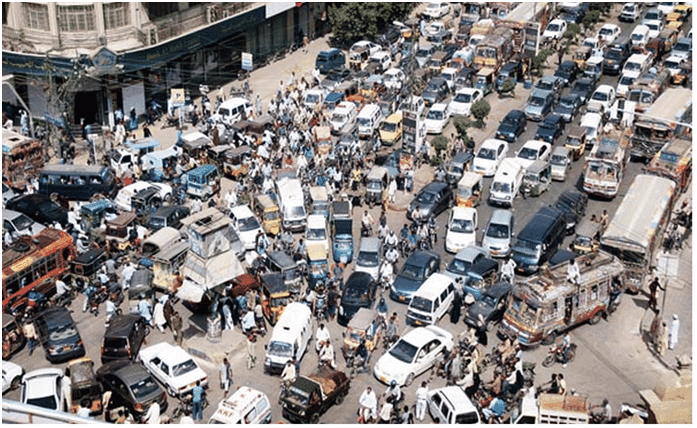

BY SHANZAY ASIM

Haamiz Ahmed
• A city loved through the ages now needs regulation
Lahore is one of those enigmatic cities with a long and fascinating history.Estimated to be around
4,000 years old, the city of gardens – with its historic gates – has endured the test of time.
According to UN World Urbanisation Prospects, it is host to over 9 million people and has always
been a cultural and artistic hub. Despite being ravaged by invaders constantly in the past, Lahore
has retained its charm to this day. A darling of the Mughals and the finely tended favourite of the
British Raj, Lahore has been enticing people for centuries.
The Charm of Lahore
Being as long-lasting s it is, Lahore has traces of architecture and culture from innumerable sources.
From Gandharan art to digital styles prominent today, it has everything. After all, the Lahore Museum
does showcase this diversity through the two very significant sculptures of the Starving Buddha and
the bronze statue of Queen Victoria, two leaders who were worlds and eras apart and yet, left their
influence on Lahore. It is a city of beauty and contrasts where modern high rise buildings sit right
down the road from tombs built in the Mughal area.
Lahore has always had a central role in the region and is the hub of cultural activity in Pakistan. It is
home to organisations like the Alhamra Art Council, which promotes art and cultural activity in the
city. Festivals. An eclectic variety of plays are staged by these institutions, ranging from Shakespeare
to Punjabi love stories to French surrealist drama. Literature and music has always been appreciated
by the populace of Lahore, as evidenced by the emergence of literary and music festivals in the past
few years.
Lahore is also a hotbed for tourism due to its historical monuments. The grand Badshahi Mosque and
the picturesque Shalimar Gardens are both UNESCO World Heritage Sites and are prime examples of
the grandeur of ancient Lahore. The Walled City Project is also working on restoring the ancient gates
of Lahore and making it a must-visit destination for both domestic and foreign tourists. Even the
shops on the everlasting Mall Road and its post office are located in gorgeous buildings with marble
facades from the British era. This hodgepodge architecture of the city, vastly differing in different
areas, lends it a certain beauty that pulls people to it.
Perhaps the most well-known feature of Lahore is its fame as a haven for food lovers. The people of
Lahore are known for being highly enthusiastic about food and thus it is no surprise that Lahore has
three dedicated food streets. The old food street in Gawalmandi may not have its previous splendour
anymore, but loyal patrons of its restaurants still visit it regularly. The alternative to this food street
has been made in the most beautiful of locations, right next to the Badshahi Mosque, with colourful
buildings and sizzling traditional food.For the more sophisticated lot with a more diverse palate, MM
Alam Road holds a number of eateries of all types. Basically, no one can leave disappointed with the
food in Lahore.
Lahore is also famous for its quality education at all levels. Pre-partition institutes like the Govern-
ment College University, Forman Christian College, and Aitchison have been imparting international
standard education for almost 2 centuries now. Lahore also has modern institutes like LUMS, which
attracts students from all over the country. People in smaller towns in Punjab also relocate their
families to educate their children in Lahore. Hence, it can safely be called the centre of education
for Pakistan.
In recent years, Lahore’s population has increased drastically. What was once 6 million in 1998
is now estimated to be at least 9 million (or even up to 10 million?). This is not just a natural rise,
but is mostly due to people from all over the country migrating to Lahore for various reasons.
Lahore is a central city with many industries located around it, so a major reason for migration to
Lahore is due to the search for employment. Various manufacturing and service industries are
based in the city, so people see it as a land of opportunities and prosperity. Lahore also has
excellent infrastructure in place, making it a convenient and attractive city for people to live in.
Access to high quality education and employment is also marginally much higher than in smaller cities,
towns, and villages. Hence, people are drawn to the city in droves.
All of these factors have attracted a variety of people to Lahore, and make it their home. Statistics
on Zameen.com show that the demand for houses and plots in Lahore is much higher than anywhere
in Pakistan.This has led to multiple housing societies being built in Lahore and there are no signs of
this trend slowing down. What was once a small gated city has now spread expansively in all directions
and is home to a vast variety of people. The legacy of Lahore as a city that entices people is going
strong and despite the day and age, it shows no signs of fading.
The Cost of Progress
All of this influx of people into Lahore may seem all well and good currently, but it will lead to harrowing
events in the future. Throughout history, the fall of such great cities has been due to negligence and it
can be stated, a bit of arrogance in their splendour. A prime example would be Pompeii, which was right
at the foot of the volcano Mount Vesuvius, which erupted and decimated the city and its residents.
Lahore is bringing about its own Mount Vesuvius, albeit in a different form, with the lack of attention to
sustainable growth. It should be blindingly obvious that a place does not have unlimited resources and
land to support an ever-increasing population. This becomes doubly troubling when the resources, i.e.,
fertile land is being utilized to further accommodate the growing population.
Such unregulated growth with no consideration of the long-term can be disastrous. The environmental
impact is already visible as evidenced by the debilitating smog experienced by Lahore in the winter of
2016. Furthermore, access to clean drinking water and electricity is also becoming increasingly difficult,
as the demand for these resources has skyrocketed over the years, at a much faster rate than their
production.
In conclusion, strict measures need to be taken to make Lahore a sustainable city and prevent it from
growing haphazardly as it is. Focus on vertical construction rather than urban sprawl should be there,
and localities arranged in such a way that Lahore does not become congested and eventually become
an uninhabitable city. Surely, no one wants such an enduring and monumental city to collapse due to
sheer carelessness. Lahore’s legacy can still be saved, but only if action is taken immediately.

Shanzay Asim
Shanzay Asim is a writer based in Lahore. She has an avid interest in social issues and uses the written word to tell her stories.
You can reach her at asim.shanzay@gmail.com.
Source:Pakistan Today, JUNE 29, 2017
Send email to nazeerkahut@punjabics.com with questions, comment or suggestions
Punjabics is a literary, non-profit and non-Political, non-affiliated organization
Punjabics.com @ Copyright 2008 - 2018 Punjabics.Com All Rights Reserved
Website Design & SEO by Webpagetime.com